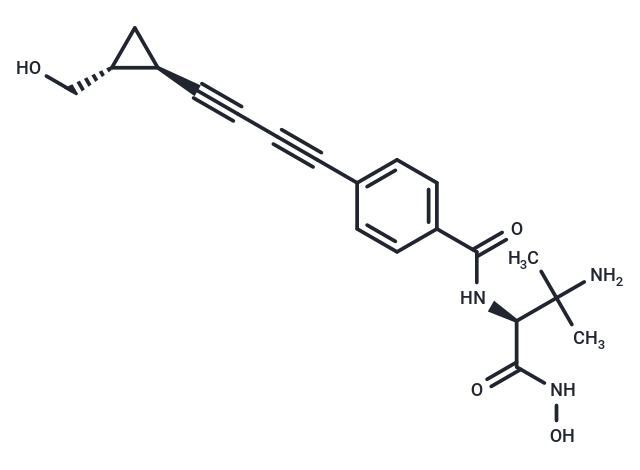Shopping Cart
- Remove All
 Your shopping cart is currently empty
Your shopping cart is currently empty
ACHN-975 is a highly potent and selective LpxC inhibitor, demonstrating subnanomolar inhibitory activity. It effectively targets a broad spectrum of gram-negative bacteria, with low minimum inhibitory concentration (MIC) values (≤1 μg/mL)[1].

| Pack Size | Price | Availability | Quantity |
|---|---|---|---|
| 25 mg | $3,570 | 3-6 months | |
| 50 mg | $4,480 | 3-6 months | |
| 100 mg | $5,900 | 3-6 months |
| Description | ACHN-975 is a highly potent and selective LpxC inhibitor, demonstrating subnanomolar inhibitory activity. It effectively targets a broad spectrum of gram-negative bacteria, with low minimum inhibitory concentration (MIC) values (≤1 μg/mL)[1]. |
| In vitro | ACHN-975 is effective against Enterobacteriaceae spp with an IC50 of 0.02 nM[1] and shows MIC90 values of 1, 0.5, and >64 μg/mL against Enterobacteriaceae spp, Pa, and Ab, respectively[1]. ACHN-975 is also active against six P. aeruginosa isolates, with MIC values of 0.12, 0.06, and 0.06 μg/mL for APAE1064, APAE1232, and APAE1064 isolates, respectively[2]. It exhibits MIC50 and MIC90 values of 0.06 and 0.25 μg/mL against Pseudomonas aeruginosa[2] and inhibits 100% of the tested P. aeruginosa isolates at an MIC of ≤2 μg/mL. LpxC, a highly conserved enzyme in gram-negative bacteria, catalyzes the first committed step of lipid A biosynthesis and is characterized as a Zinc-dependent metalloamidase UDP-3-O-[(R)-3-hydroxymyristoyl]-N-acetylglucosamine deacetylase[1]. |
| In vivo | ACHN-975 (intraperitoneal administration; 5-30 mg/kg; single dose) causes a steady reduction in bacterial titers within the first 4 hours across all dosing groups, indicating that the level of free drug falls below the MIC for this isolate (0.25 μg/ml) by 2 hours after a 10 mg/kg dose and by 4 hours after a 30 mg/kg dose[2]. |
| Molecular Weight | 369.41 |
| Formula | C20H23N3O4 |
| Cas No. | 1410809-36-7 |
| Relative Density. | no data available |
| Storage | Powder: -20°C for 3 years | In solvent: -80°C for 1 year | Shipping with blue ice/Shipping at ambient temperature. |

Copyright © 2015-2025 TargetMol Chemicals Inc. All Rights Reserved.